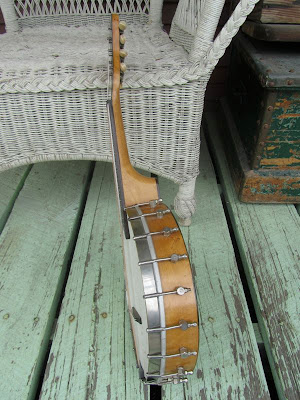c.1930 Slingerland Banjo-Mandolin
This banjo-mando dates to around 1925-1930. This same model is often seen in Lyon & Healy catalogs under their own house brands and also under several retailer brands. The mark on this one is "Slingerland" and because this or similar instruments (same hardware, rim style, headstock shape, scale length, materials, etc.) shows up so often I get the feeling these were all built by a Chicago jobber that wasn't Slingerland itself. For what it's worth, I have a hunch that these were made by Regal, but I can't tie it all together (yet).
Anyhow, this is a customer's instrument and the mission here was to get it playable again. This included a fret level/dress (much divoting on the 1st 5th frets), new bridge, replacement tailpiece, and setup -- which was really tedious because it was difficult to get a good break-angle on the strings at the bridge from the tailpiece side of things because the instrument had "settled" over time and too-heavy string tension.
Head is a replacement Remo, a bit dirty, but in good shape.
Dyed-black fretboard and bridge. Ebony nut.
The board is a nice thick slab which means the extension has maintained proper straightness. Pearl dots. I've got 32w-9 "ultra light" mando strings on here, though with the 13 7/8" scale 28w-8 strings could work very well, too.
Good multi-ply maple rim and sturdy maple neck.
Hardware is in decent shape.
Waverly tuners are valuable in themselves. Ivoroid buttons, too. I had to replace one of the screws since one was a weirdo replacement to begin with.
See the huge "aftermarket" screw installed into the heel? Crude but effective...
I'm not entirely sure this neck brace is original, either. My guess is it should have had the square-shaped braces I usually see on Chicago-made instruments rather than this more "East Coast" Vega-style brace. My reasoning...? The brace here is near the end of its adjustment limit with the mounting hole for the pin so far forward, but that would be normal on one of the more square ones that adjusts from the top down.
Slingerland stamp.
This banjo-mando has a good, full, sound. It's not piercing or shrill, probably because of the lack of a tonering. It has a simple shaped-top rim.
I had to replace the original tailpiece (a "Bell Brand" type) since it had warped out of shape. I had this mangled old mando tailpiece in my parts bin and since they're commonly used on banjo mandos of the period (with modifications) I figured it wouldn't hurt. They also work a heck of a lot better than, say, a replacement "No Knot" or "Model A" tailpiece style.
If you look closely, you'll see that I needed to grind down the tension hoop to bring the tailpiece edge closer to the head. This let me get proper back-angle on the strings at the bridge. This instrument had settled over time due to excessive string tension (medium mando strings) and so the neck angle wasn't quite right, even though it was shimmed up and the dowel-set was good. To reshape a heel is time-consuming and expensive for the customer. To grind this down is not! -- and with the other various abnormalities (note plugged pickup jack hole), simply has no effect on value.















Comments